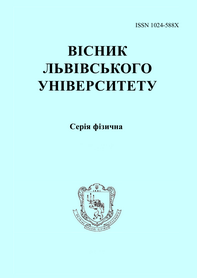Visnyk of the Lviv University. Series Physics
56 (2019) с. 112-121
DOI: https://doi.org/10.30970/vph.56.2019.112
Analysis of correlations among the structural and refractive parameters of ABSO4 crystals
P. Shchepanskyi, M. Rudysh, R. Matviiv, V. Stadnyk, R. Brezvin, O. Kushnir, L. Karpliuk
|  |
The links among refractive and structural characteristics of ABSO4 crystals are analyzed. Several relationships are found that manifest fair correlation coefficients. We are mainly interested in the correlations that involve two parameters only (n and \overline{a}, n and Egcalc, etc). The average refractive index n is compared with the following parameters: the average lattice parameter \overline{a}; the average ionic radius r of the alkali cations; the lattice-cell volume per one sulfur atom VS; the density \rho of a crystal; three different combinations of \rho and the average atomic mass M of a crystal; the effective position \lambda0 of ultraviolet absorption band and the parameter B of the ultraviolet oscillator averaged over x, y and z; the parameters R and \alpha averaged in the same manner as \lambda0 and B (note that R and \alpha are dependent and proportional to each other). Standard correlation analysis was used to verify possible predictive relationships between the variables involved, and a Pearson coefficient r for the linear correlation to determine the degree of interdependence of those variables. For the case of low-symmetry ABSO4 crystals, we report on extremely high correlations of average refractive index with average lattice cell parameter and ionic radius of alkali cation. Moreover, the refractive index correlates perfectly with specific combinations of crystal density and average atomic mass, which have earlier been suggested theoretically. Besides, we obtain a good correlation of the refractive index with unit cell volume per one sulfur atom. The refractive index shows weak correlations with the Sellmeier parameters \lambda0 and B but on the other hand, we have a strong positive correlation for the n(R) or n(\alpha) dependences. Our correlation analysis demonstrates a number of practical resources for forecasting the refractive properties of new ABSO4 crystals, basing on their structure.
Full text (pdf)
References
- W. Ackermann, Ann. Phys. 351, 197–220 (1915).
- K. Rao, N. Rao, J. Mater. Sci. 1, 238-248 (1996).
- L. Diosa, G. Gonzales-Montero, A. Vargas, Phys. Stat. Sol. (b). 220, 647-650 (2007).
- R. Lima, J. Sasaki, P. Freire, A. Ayala, I. Guedes, F. Melo, F. Mendes, Journal of Physics Condensed Matter. 12, 7559-7568 (2000).
- A. Righi, J. Salvestrini, P. Bourson, R. Moreira, R. Fontana, Appl. Phys. B. 67, 559-562 (1998).
- M. El-Muraikhi, M. Kassem, M. Gaafar, M. Abdel Gawad, I. Ragab, Phys. Stat. Sol. (a). 202, 163-169 (2005).
- M. Romanyuk, M. Romanyuk, Ferroelectrics. 317, 57–61 (2005).
- V. Stadnyk, M. Romanyuk, R. Brezvin, Ferroelectrics. 192, 203-207 (1997).
- V. Stadnyk, Електронна поляризовність фероїків (Ivan Franko LNU, 2014). Lviv.
- A. El-Korashy, H. El-Zahed, M. Radwan, J. Appl. Phys. 64, 2141-2146 (2003).
- R. Brezvin, Оптико-електронні параметри фероїків групи сульфатів та цинкатів (Liga-Press, 2018). Lviv.
- M. Romanyuk, J. Phys. Stud. 10, 358-380 (2006).
- V. Stadnyk, M. Romanyuk, O. Kushnir, R. Brezvin, A. Franiv, International Journal of Modern Physics B.24, 6219-6233 (2010).
- V. Gaba, V. Stadnyk, O. Kushnir, O. Chizh, Opt. Spectrosc. 110, 967-972 (2011).
- M. Rudysh, M. Brik, O. Khyzhun, A. Fedorchuk, I. Kityk, P. Shchepanskyi, V. Stadnyk, G. Lakshminarayana, R. Brezvin, Z. Bak, M. Piasecki, R. Brezvin, RSC Adv. 7, 6889–6901 (2017).
- P. Shchepanskyi, O. Kushnir, V. Stadnyk, A. Fedorchuk, M. Rudysh, R. Brezvin, P. Demchenko, A. Krymus, Ukr. J. Phys. Opt. 18, 187–197 (2017).
- P. Shchepanskyi, O. Kushnir, V. Stadnyk, R. Brezvin, A. Fedorchuk, Ukr. J. Phys. Opt. 19, 141-149 (2018).
- Z. Yariv and P. Yeh, Optical waves in crystals: propagation and control (Wiley, NY, 2003).
- Ch. B\"aumer, D. Berben, K. Buse, H. Hesse, J. Imbrock, Appl. Phys. Lett. 82, 2248-2250 (2003).
- O. Kushnir, O. Dzendzelyuk, V. Hrabovskyy, O. Vlokh, Ukr. J. Phys. Opt. Phys. 5, 1-5 (2004).
- C. Henry, J. Appl. Phys. 143, 627-633 (1966).
- M. Karppinen, Acta Cryst. B. 71, 334-341 (2015).
- J. Rodgers, W. Nicewander, The American Statistician. 42, 59-66 (1988).
- A. Buda, A. Jarynowski, Wydawnictwo Niezalezne. 1, 5-21 (2010).
- L. Akselrud, Y. Grin, Appl. Cryst. 47, 803-805 (2014).
- J. Emsley, Oxford: Clarendon Press. 264 (1991).
- A. Jain, S. Ong, G. Hautier, W. Chen, W. Richards, S. Dacek, S. Cholia, D. Gunter, D. Skinner, G. Ceder, K. Persson, APL Materials. 1, 011002 (2013).
- H. Kimura, A. Miyazaki, Japan. J. Appl. Phys. 41, 5334-5335 (2002).
- R. Ratheesh, H. Sreemoolanadhan, M. Sebastian, J. Solid State Chem. 2-8, 054308 (1997).
- Calculation of the refractive index of glasses. In: Statistical Calculation and Development of Glass Properties. Retrieved from :https://www.glassproperties.com/refractive\_index.
- S. Maj, Phys. Chem. Miner. 10, 133-136 (1984).

